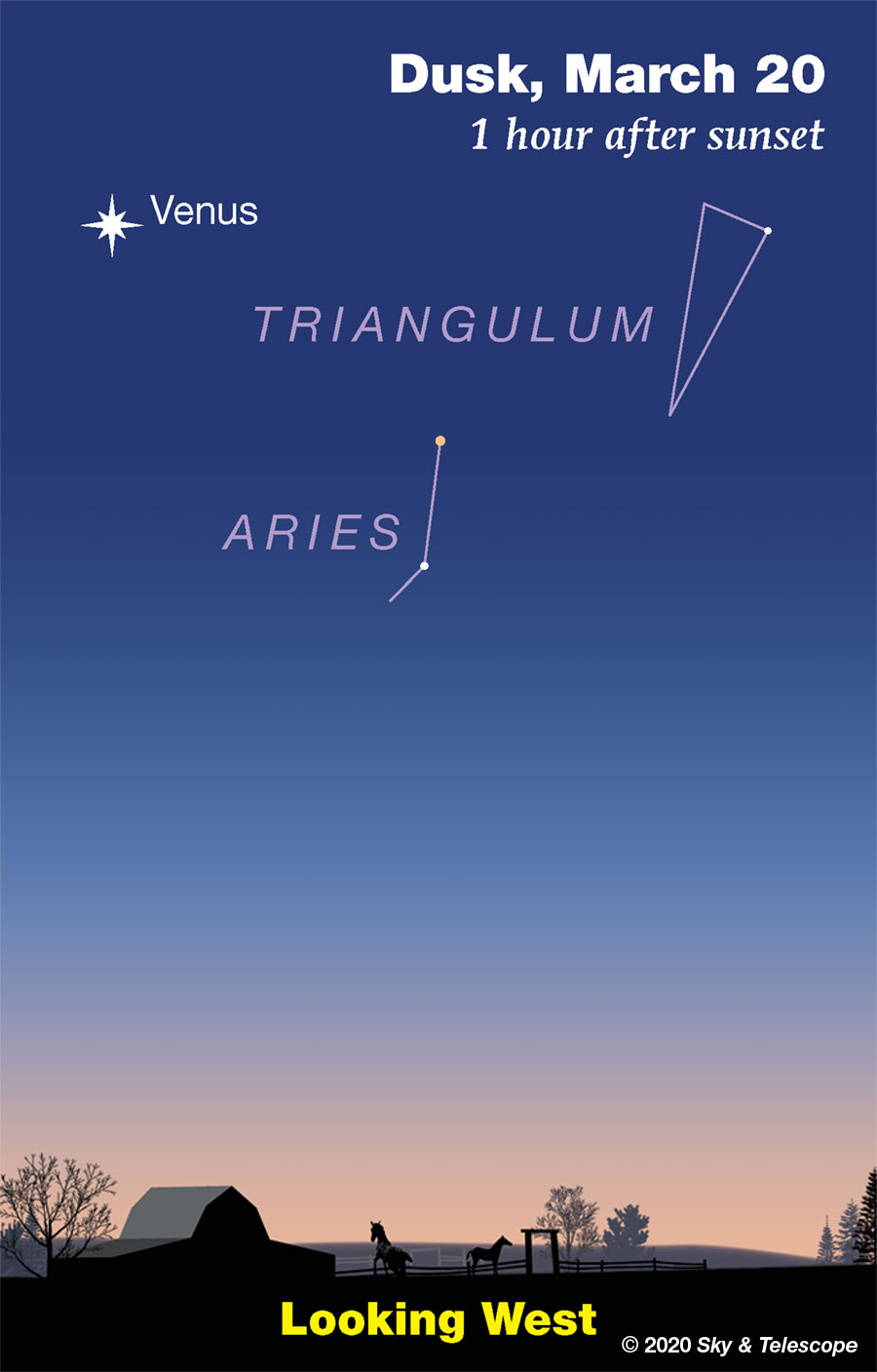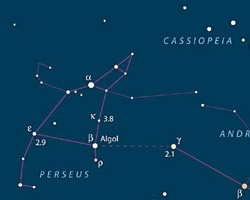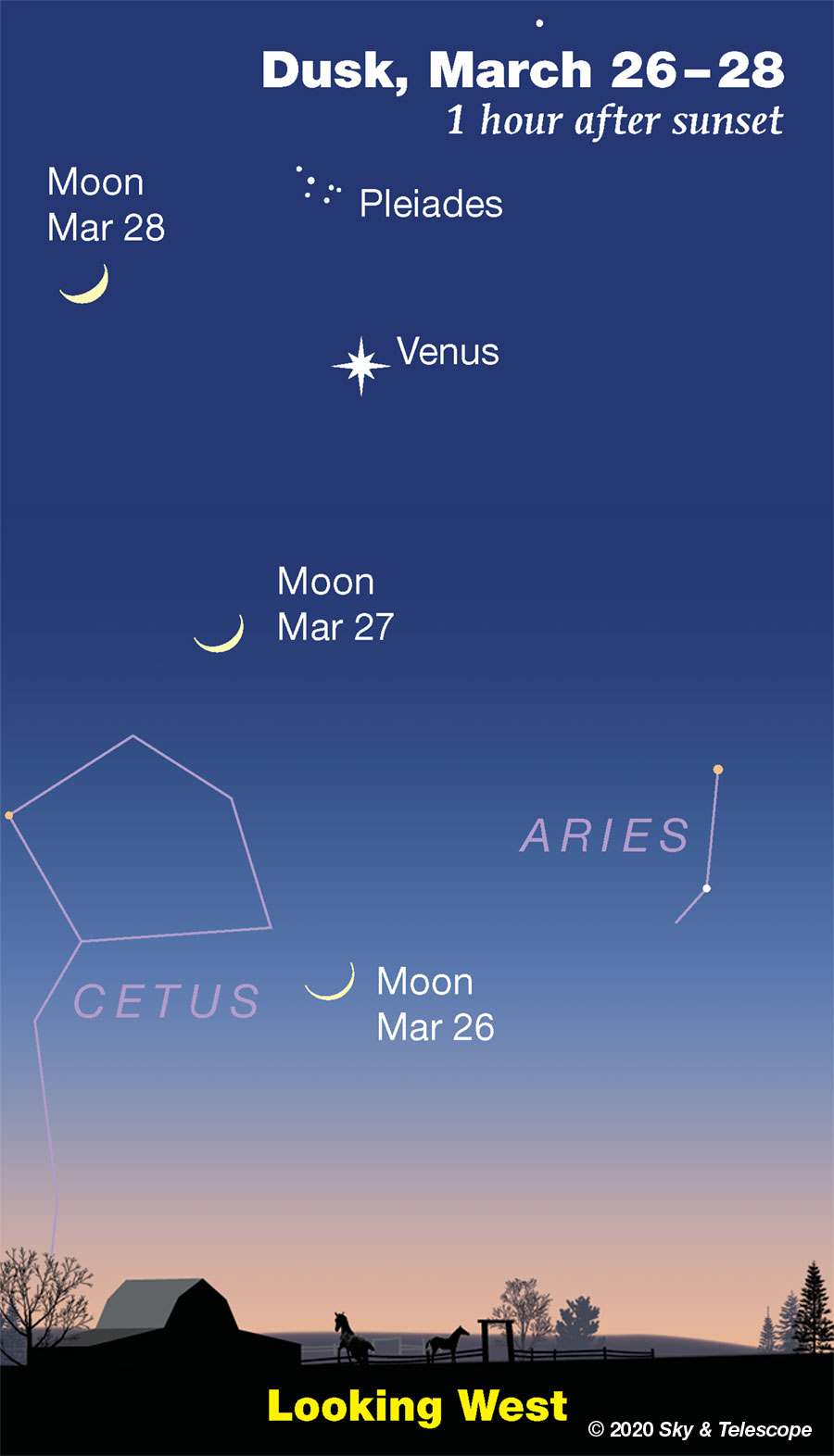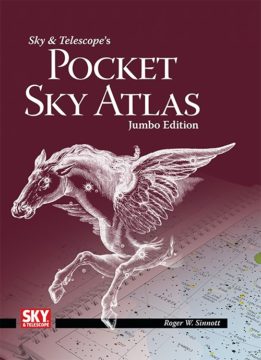The Betelgeuse watch. After bottoming out at about V magnitude +1.64 in early to mid-February, Orion's Betelgeuse was up to +1.0 as of March 22nd. The change from its minimum is obvious to the eye.

Friday, March 20
• Look for Arcturus, the Spring Star, very low in the east-northeast after nightfall, then higher in the east later in the evening. By modern measurements Arcturus is visual magnitude –0.05, making it the fourth-brightest nighttime star. It's bested only by Sirius, Canopus, and Alpha Centauri (if you combine the light of Alpha Cen A and B; the pair blend to appear single to the unaided eye).
For northerners who can never see Canopus or Alpha Cen, Arcturus is bested by only Sirius! But Vega and Capella are very close on its heels.
• Early in the dawn of Saturday March 21st, look southeast to catch bright Jupiter, little Mars still close to it, and Saturn 7° to Jupiter's lower left.
Then as dawn grows brighter, keep watch just above the east-southeast horizon, very far to the planets' lower left, for the rising of the thin crescent Moon — with little Mercury about 5 ° to its left or upper left (for North America). Binoculars help! Your best chance will probably be about 20 or 30 minutes before sunrise.
Saturday, March 21
• The Big Dipper glitters softly high in the northeast after nightfall, standing on its handle. You probably know that the two stars forming the front of the Dipper's bowl (currently on top) are the Pointers; they point to Polaris, currently to their left.
And, you may know that if you follow the curve of the Dipper's handle out and around by a little more than a Dipper length, you'll arc to Arcturus, now rising in the east.
But did you know that if you follow the Pointers backward the opposite way, you'll land in Leo?
Draw a line diagonally across the Dipper's bowl from where the handle is attached, continue far on, and you'll go to Gemini.
And, look at the two stars forming the open top of the Dipper's bowl. Follow this line past the bowl's lip far across the sky, and you cruise to Capella.
Sunday, March 22

κ).• Algol goes through one of its self-eclipses this evening as its constellation Perseus, upper right of Venus, declines in the northwest. Algol should be at its minimum light, magnitude 3.4 instead of its usual 2.1, for a couple hours centered on 10:30 p.m. EDT. Algol takes several additional hours to fade and to rebrighten.
Monday, March 23
• Castor and Pollux shine together nearly overhead in the south after dark. Pollux is slightly the brighter of these "twins." Draw a line from Castor through Pollux, follow it farther out by a big 26° (about 2½ fist-widths at arm's length), and you're at the dim head of Hydra, the Sea Serpent. In a dark sky the head of Hydra is a subtle but distinctive grouping, about the size of your thumb at arm's length. Binoculars show it easily through light pollution or moonlight.
Continue the line farther by a fist and a half and you hit Alphard, Hydra's orange heart. It's 2nd magnitude.
Another way to find the head of Hydra: It's almost midway from Procyon to Regulus.
Tuesday, March 24
• Venus is at greatest elongation, 46° east of the Sun. This is when we see Venus 50% sunlit, geometrically speaking. But in practice, the lighting at the terminator is so weak, compared to Venus's brilliant surface elsewhere and perhaps your twilight sky, that the terminator isn't quite visible in a telescope — and so Venus looks a few days past dichotomy. How accurately can you judge this subtle effect?
• New Moon (exact at 5:28 a.m. EDT).
Wednesday, March 25
• The bright star high in the west-northwest during and after dusk is Capella. Its pale-yellow color matches that of the Sun, meaning they're both about the same temperature. But otherwise Capella is very different. It consists of two yellow giant stars orbiting each other every 104 days.
Moreover, for telescope users, it's accompanied by a distant, tight pair of red dwarfs: Capella H and L, magnitudes 10 and 13. Article and finder charts.

Thursday, March 26
• Spot the thin crescent Moon low in twilight, far below Venus as shown above. And watch the Pleiades sinking closer toward Venus day by day. On April 3rd, Venus will shine just inside their left edge.
Friday, March 27
• Now the Moon is thicker and closer to Venus, as shown above.
• The signature fall-and-winter constellation Cassiopeia retreats down after dark. Look for it fairly low in the north-northwest. It's standing roughly on end.
But for skywatchers at mid-northern latitudes Cassiopeia is circumpolar, never going away completely. By midnight or 1 a.m. it's at its lowest due north, lying not quite horizontal.
Saturday, March 28
• The waxing crescent Moon shines some 8° left of Venus in twilight. As night deepens, you'll find them forming a triangle with the fingertip-sized Pleiades over them, as shown above.
• This is the time of year when the dim Little Dipper juts to the right from Polaris (the Little Dipper's handle-end) during late evening. By that time the much brighter Big Dipper curls over high above it, "dumping water" into it. The dippers do the reverse water dump in the fall.
This Week's Planet Roundup
Mercury (magnitude+0.2) is having a poor apparition very low in the dawn. Use binoculars to look for it just above the east horizon about 30 minutes before sunrise. It's far to the lower left of Jupiter, by some 45 ° (about four or five fists at arm's length). Nothing else in that area is as bright.
Venus (magnitude –4.2, in eastern Pisces) is the big, bright white "Evening Star" blazing high in the west during and after twilight. Venus doesn't set now (in the west-northwest) until a good 2½ hours after complete dark.
In a telescope, Venus is just about at dichotomy (appearing half lit) and 23 arcseconds in diameter. It will continue to enlarge in size and wane in phase for the next two months, becoming a dramatically thin crescent in May.
Earth, best visible in the daytime, is centered below you. Its disk is a remarkable 180° in apparent diameter, currently 18,000 times larger than the apparent diameter of Jupiter, the planet currently in second place in this regard. But local details usually complicate the limb, and perspective effects limit how much of the planet is observable at once. Surface detail can be seen without a telescope.
Mars, Jupiter, and Saturn (magnitudes, +0.9, – 2.1, and +0.7, respectively) are grouped low in the southeast as dawn begins. Jupiter is by far the brightest and catches your eye first . Little Mars is moving away from Jupiter eastward toward Saturn, after passing Jupiter by 0.7° on March 20th. By the 27th Mars is 3° from Saturn, and they pass each other by 1° on the 31st.
Saturn is 7° lower left of Jupiter.
Uranus (magnitude 5.8, in southwestern Aries) is sinking ever farther below Venus in the west after dark.
Neptune is hidden deep in the glow of sunrise.
All descriptions that relate to your horizon — including the words up, down, right, and left — are written for the world's mid-northern latitudes. Descriptions that also depend on longitude (mainly Moon positions) are for North America.
Eastern Daylight Time (EDT) is Universal Time (UT, UTC, GMT, or Z time) minus 4 hours.
Want to become a better astronomer? Learn your way around the constellations. They're the key to locating everything fainter and deeper to hunt with binoculars or a telescope.
This is an outdoor nature hobby. For an easy-to-use constellation guide covering the whole evening sky, use the big monthly map in the center of each issue of Sky & Telescope, the essential guide to astronomy.

Once you get a telescope, to put it to good use you'll need a detailed, large-scale sky atlas (set of charts). The basic standard is the Pocket Sky Atlas (in either the original or Jumbo Edition), which shows stars to magnitude 7.6.
Next up is the larger and deeper Sky Atlas 2000.0, plotting stars to magnitude 8.5; nearly three times as many. The next up, once you know your way around, are the even larger Interstellarum atlas (stars to magnitude 9.5) and Uranometria 2000.0 (stars to magnitude 9.75). And read how to use sky charts with a telescope.
You'll also want a good deep-sky guidebook, such as Sue French's Deep-Sky Wonders collection (which includes its own charts), Sky Atlas 2000.0 Companion by Strong and Sinnott, or the bigger Night Sky Observer's Guide by Kepple and Sanner.
Can a computerized telescope replace charts? Not for beginners, I don't think, and not on mounts and tripods that are less than top-quality mechanically (meaning heavy and expensive). And as Terence Dickinson and Alan Dyer say in their Backyard Astronomer's Guide, "A full appreciation of the universe cannot come without developing the skills to find things in the sky and understanding how the sky works. This knowledge comes only by spending time under the stars with star maps in hand."
![]() Audio sky tour. Out under the evening sky with your earbuds in place, listen to Kelly Beatty's monthly podcast tour of the heavens above. It's free.
Audio sky tour. Out under the evening sky with your earbuds in place, listen to Kelly Beatty's monthly podcast tour of the heavens above. It's free.
 16
16








Comments
Pencil BFB
March 20, 2020 at 7:27 am
On 20 March at 11:49 AM UTC+8, we have entered spring.
Also, if you read my comment on "The Fall and Rise of Betelgeuse" that I said on 28 February, it said: "A week ago (corresponding to 21 February at 8:00 PM UTC+8), I saw Betelgeuse having around the same brightness as Bellatrix. I will observe again soon." As of 20 March 7:15 PM UTC+8, Betelgeuse seems to be a little brighter than Bellatrix but still not as bright as Rigel, giving me a magnitude estimate of +1.2, up from +1.6 from my previous observation.
You must be logged in to post a comment.
Rod
March 20, 2020 at 11:34 am
Pencil BFB, Rod in MD here. Thanks for your observations. Much better than chasing COVID-19 reports 🙂
You must be logged in to post a comment.
Rod
March 20, 2020 at 11:33 am
Okay, here is my observation of Mars and Jupiter close conjunction this morning in Sagittarius. "I viewed this close conjunction early this morning using my 90-refractor telescope with 14-mm eyepiece. 71x with true FOV a bit larger than 1-degree in the eyepiece. Jupiter, Europa, Ganymede, and Callisto moons visible with cloud belts on Jupiter and Mars, small distinct planetary disk shape about 6" angular size, orange-red hue. I created charts using Starry Night and Stellarium software with MS Power Point slides. Very lovely views with waning crescent Moon low in SE sky behind trees near my horse barn. I also observed using 10x50 binoculars that provided very good views. I was out from 0600 to 0652 EDT or 1000 UT to 1052 EDT. Altocumulus clouds and cirrus caused some problems at times. Winds aloft according to NWS for my area, 260/50 to 260/70 knots from 9,000 to 30,000 feet altitudes so clouds from the west blew over and more later as 0700 approached and by 0652, Jupiter and Mars disappeared from view. I am tracking Mars since 06-Dec-19 when it was in Libra, this morning moving through Sagittarius and closing with Saturn end of the month. Time well spent vs. thinking about COVID-19 news reports Mars opposition in October this year. Mars will be in Pisces then and a bit larger than 22" angular size compared to this morning size, 6". Looking forward to clear skies and excellent Mars opposition viewing later this year.
You must be logged in to post a comment.
Alan MacRobertPost Author
March 21, 2020 at 10:43 am
Rod, Thank you for sharing your logbook entry. I've kept logs of even minor observations, and the experiences around them, ever since I was a teen -- inspired by something I must have read in Sky & Tel. They've always added greatly to my experience of astronomy. The old ones are still a treasure to look back into from time to time.
I did give myself a warning, though -- Don't take log-keeping so seriously that you feel obligated or guilty. It's fine to skip it when you don't feel like it.
--Alan MacRobert
You must be logged in to post a comment.
Alan MacRobertPost Author
March 21, 2020 at 11:37 am
Anthony,
> It looks like he's been writing "This Week's Sky at a Glance" since April 2007.
Oh long before that! This Week's SAAG dates from 1988 or maybe 1989. Back when computer communications were new, Kelly Beatty was in touch with some people who were creating innovative new "Forums" for a thing called Compuserve, which was trying to become a big deal in the dial-up world. They wanted regular weekly content for an Astronomy Forum, since astro-geeks tended to be ahead of the curve on getting computers. Kelly being the visionary idea guy and people-networker that he's always been (to Sky & Telescope's vast benefit over the decades), the rest was history.
For a few months our late publisher Bill Shawcross wrote the sky sights and the Planet Roundup -- even then it was called "Sky at a Glance" -- and then he handed off the job to me, and I've been doing it ever since.
I remember how amazing it was to call it up onscreen over the phone, and watch the green letters scroll sideways across the screen at 300 baud, faster than any human being could possibly type!! It's been through many design changes in 32 years, but its structure, purpose, and intended readers are the same.
If there's ever some award for the oldest continuously published online-only periodical, I'd like to put This Week's Sky at a Glance in contention.
--Alan MacRobert
You must be logged in to post a comment.
New Jersey Eclipse Fan
March 20, 2020 at 5:40 pm
Very clever Earth entry under "THIS WEEK'S PLANET ROUNDUP." A premature April Fool's, perhaps?
You must be logged in to post a comment.
Cascade
March 20, 2020 at 6:02 pm
Thanks Alan. I had really been having a hard time finding it in my telescope, and your article fully cleared it up.
I just look a little further down and I can now fully see the third planet from our sun, but you are right it is easier to see in the day!!
You must be logged in to post a comment.
PGT
March 20, 2020 at 8:00 pm
Kudos to whoever added "Earth" to the THIS WEEK'S PLANET ROUNDUP.
: )
You must be logged in to post a comment.
Anthony Barreiro
March 21, 2020 at 12:20 am
That would have been Alan MacRobert. If you click on his byline above you can read the most recent 1062 articles he's written for Sky and Telescope. It looks like he's been writing "This Week's Sky at a Glance" since April 2007.
You must be logged in to post a comment.
Alan MacRobertPost Author
March 21, 2020 at 10:46 am
(Blush.) That was me. I'm careful to insert that paragraph only once every few years. It would get old really fast if overused!
--Alan MacRobert
You must be logged in to post a comment.
Anthony Barreiro
March 21, 2020 at 6:37 pm
Thank you very much, Alan. This Week's Sky at a Glance has been my guiding light for these past twenty years that I've been seriously watching the sky. I've added other references to my routine, but I still always look forward to reading TWSAAG every Friday.
The first TWSAAG in your portfolio here on S&T.com is from April 2007. It's good to know the history going back to Compuserve days.
You must be logged in to post a comment.
Rod
March 26, 2020 at 9:45 am
Lovely sky with Jupiter, Mars, and Saturn close together along the ecliptic this morning near 0600 EDT in Maryland. Sagittarius and Scorpius constellations quite obvious too. I enjoyed the view from a larger horse pasture area near my place. Clear skies, temperature 1C. Mars passes Saturn < 1-degree apart near 0600 EDT on Tuesday morning next week, the 31st.
You must be logged in to post a comment.
You must be logged in to post a comment.